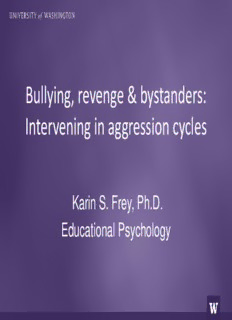
Bullying, revenge & bystanders: Intervening in aggression cycles PDF
Preview Bullying, revenge & bystanders: Intervening in aggression cycles
Bullying, revenge & bystanders: Intervening in aggression cycles Karin S. Frey, Ph.D. Educational Psychology Why do we care about bullying? Bullying behavior uses covert (e.g., gossip) & overt tactics (insults, assault) to harm those of less power Chronic bullying repeatedly targets individual(s) – Predicts increased physical illness (Rigby, 199) – Predicts increased aggression even when controlling genetic disposition for aggression (Brendgen, Vitaro, et al., 2011) – Predicts increased depression & suicide – Depression lifts when abuse stops, supporting causal influence Experimental Social Exclusion • Causes loss of self-regulatory ability • Elicits a state of cognitive deconstruction – Typical of suicidal individuals – Emotional blunting – Avoidance of self-awareness – Slowed reaction times & reduced task effort – Lack of future orientation – Impulsivity, attraction to immediate gratification Victimization reduces access to educational opportunity • Class participation declines • Academic achievement declines; rebounds when victimization ends • Participation in extracurricular activities declines (sports, school dances) • School ‘shopping,’ drop-out increases • Increases all students’ anxieties about safety Separate Traditions: Aggression & Bullying Social cognitive theories of aggression (Dodge) • Reactive or retaliatory aggression (Miller, Dodd) – ‘frustration aggression,’ originally a cartharsis model – Goal: ‘even the score’ – High arousal & dysregulation (Hubbard et al., 2002) • Proactive or instrumental aggression (Bandura) – ‘social learning’ that aggression will be rewarded – Goals: Obtain status and / or material resources – Calm demeanor, Masked anger (Hubbard et al., 2002) Bullying: Power the means & end • Goal: Acquisition of power justifies the means • Strategic use of power is the means to the goal • Choice of target often strategic • Cut down a potential rival for dominance • Demonstrate superiority to one’s audience • ‘Entertain’ please audience by targeting a disliked and rejected peer US Bullying Ecology • Israel > US > most Euro > Sweden – No national differences in fighting (Smith-Khuri et al., 2004) • Compared to European countries, US citizens value • equalitarian organizational structures the least • dominance structures the most (Schwartz, 2007) • Bullying aligned with levels of income inequality – Between nations and between schools (Due et al., 2009) – Within schools, poor kids targeted & harmed most Cultural Variation within US • So-called cultures of ‘honor’ privilege retaliation • White males in US south – Committed more homicides during conflicts – No differences in theft-related homicides – Masculinity threatened by insults & failure to respond – Respond more aggressively to experimenter insults if born in south or south-settled states (Cohen & Nisbett, 1996) • Some immigrants to US may have similar beliefs Likely Species-Wide Revenge Patterns • Victims – Feel entitled to behave just a little more selfishly – Believe their retaliation is equal to original offense – Often escalate somewhat • Responses appear excessive to offender – ‘Evening the score’ can endless retaliation cycles – Everyone feels like a victim
Description: